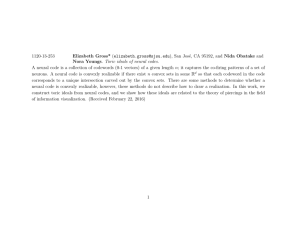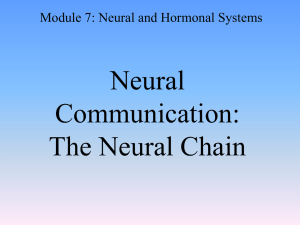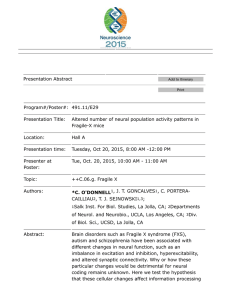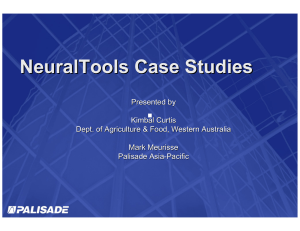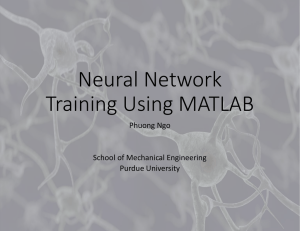Slides about IS5152 Decision Making Technologies, January 11
advertisement
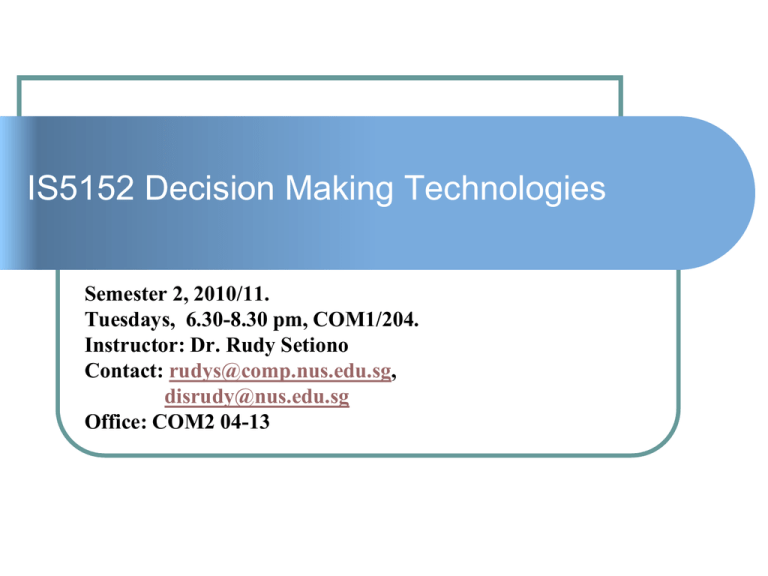
IS5152 Decision Making Technologies Semester 2, 2010/11. Tuesdays, 6.30-8.30 pm, COM1/204. Instructor: Dr. Rudy Setiono Contact: rudys@comp.nus.edu.sg, disrudy@nus.edu.sg Office: COM2 04-13 IS5152 Decision Making Technologies Course objective: to introduce students to decision making technologies that can support decision making in the financial, operational, marketing and other strategic areas. Description: Over the past two decades, increasing research efforts have been directed at finding new machine learning (ML) techniques for decision making and their possible application in solving practical problems. ML techniques such as artificial neural network methods have been proven to be powerful tools for business decision making. Among the application problems where ML techniques outperform traditional decision making methods such as statistical methods are credit rating, bankruptcy analysis, foreign exchange rate predictions and many others. IS5152 Decision Making Technologies Topics covered: The techniques covered in this course include neural networks for classification/regression/clustering, genetic algorithm for optimization, decision tree methods, support vector machine, data envelopment analysis and data mining. Journal articles that present new techniques for decision making and/or describe successful application of the existing methods in solving practical problems will be discussed in class. IS5152 Decision Making Technologies This course requires the students to have some background knowledge in: Calculus Simple linear algebra Basic probability and statistics No computer programming skill is required. IS5152 Decision Making Technologies Tentative schedule: Week 1 January 11, 2011 Introduction and class administration Week 2 January 18, 2011 Decision making under uncertainty Week 3 January 25, 2011 Optimization and decision making Week 4 February 1, 2011 Support vector machines Week 5 February 8, 2011 Decision making with multiple objectives Week 6 February 15, 2011 Data envelopment analysis February 22, 2011 No lecture. Mid-semester break Week 7 March 1, 2011 Mid-semester exam. Week 8 March 8, 2011 Decision making with decision trees and rules Week 9 March 15, 2011 Neural networks for decision making (Part 1) Week 10 March 22, 2011 Neural networks for decision making (Part 2) Week 11 March 29, 2011 Rule generation from neural networks Week 12 April 5, 2011 Genetic algorithms for decision making Week 13 April 12, 2011 Project presentation IS5152 Decision Making Technologies References: Available in the RBR sections of Central Library and HSS Business Library. 1. 2. 3. Neural networks: A comprehensive foundation Author: Haykin, Simon S Machine Learning Author: Mitchell, Tom M Operations research : applications and algorithms Author: Winston, Wayne L IS5152 Decision Making Technologies Grading: 1. Continual assessment (50%): • Midterm Exam (20%) • Class project (30%): o o o 20% for the project work, and 10% for project report and presentation. Projects are to be carried out in teams consisting n students. 2. Final exam on 6 May pm: 50%. Both midterm exam and final exam are open-book examinations. IS5152 Decision Making Technologies Class project: - Identify an interesting problem/topic to test one or more of the techniques for decision making discussed in class. - Search/find/collect relevant data. Use an available software to analyze the data. - Software will be provided or they can be obtained via the internet. - Write a (max) 20 page report. - Present the project in class (duration: 20 minutes). - More detailed instructions about the project will be given later in the semester. IS5152 Decision Making Technologies IVLE: 1. Do check IVLE for this course regularly for announcements, updates, etc. 2. All lecture materials will be placed in the workbin. 3. Message from Students Against the Violation of the Earth (SAVE): • the Office of Provost had approved the submission of all academic assignments for undergraduate and graduate studies on doublesided print or through electronic submission • you are encouraged to print your lecture notes on both sides on the paper. If possible and depending on the layout of the notes, also encourage them to print 4 to 6 pages on a side





